英国历史 美国历史
- 格式:doc
- 大小:96.50 KB
- 文档页数:8
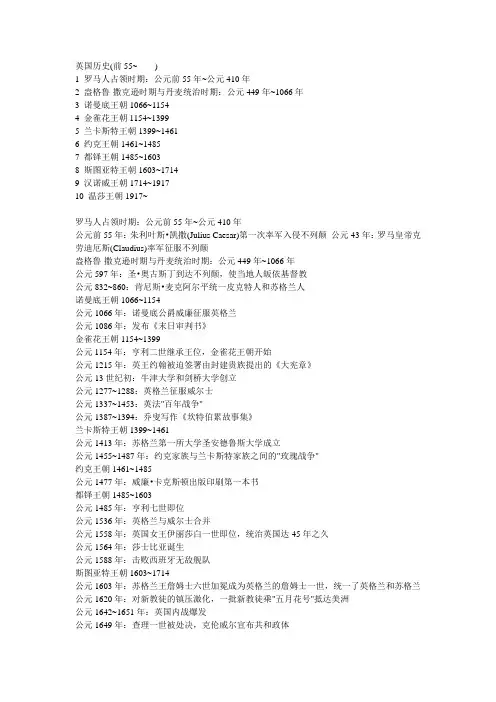
英国历史(前55~ )1 罗马人占领时期:公元前55年~公元410年2 盎格鲁-撒克逊时期与丹麦统治时期:公元449年~1066年3 诺曼底王朝1066~11544 金雀花王朝1154~13995 兰卡斯特王朝1399~14616 约克王朝1461~14857 都铎王朝1485~16038 斯图亚特王朝1603~17149 汉诺威王朝1714~191710 温莎王朝1917~罗马人占领时期:公元前55年~公元410年公元前55年:朱利叶斯•凯撒(Julius Caesar)第一次率军入侵不列颠公元43年:罗马皇帝克劳迪厄斯(Claudius)率军征服不列颠盎格鲁-撒克逊时期与丹麦统治时期:公元449年~1066年公元597年:圣•奥古斯丁到达不列颠,使当地人皈依基督教公元832~860:肯尼斯•麦克阿尔平统一皮克特人和苏格兰人诺曼底王朝1066~1154公元1066年:诺曼底公爵威廉征服英格兰公元1086年:发布《末日审判书》金雀花王朝1154~1399公元1154年:亨利二世继承王位,金雀花王朝开始公元1215年:英王约翰被迫签署由封建贵族提出的《大宪章》公元13世纪初:牛津大学和剑桥大学创立公元1277~1288:英格兰征服威尔士公元1337~1453:英法"百年战争"公元1387~1394:乔叟写作《坎特伯累故事集》兰卡斯特王朝1399~1461公元1413年:苏格兰第一所大学圣安德鲁斯大学成立公元1455~1487年:约克家族与兰卡斯特家族之间的"玫瑰战争"约克王朝1461~1485公元1477年:威廉•卡克斯顿出版印刷第一本书都铎王朝1485~1603公元1485年:亨利七世即位公元1536年:英格兰与威尔士合并公元1558年:英国女王伊丽莎白一世即位,统治英国达45年之久公元1564年:莎士比亚诞生公元1588年:击败西班牙无敌舰队斯图亚特王朝1603~1714公元1603年:苏格兰王詹姆士六世加冕成为英格兰的詹姆士一世,统一了英格兰和苏格兰公元1620年:对新教徒的镇压激化,一批新教徒乘"五月花号"抵达美洲公元1642~1651年:英国内战爆发公元1649年:查理一世被处决,克伦威尔宣布共和政体公元1660年:查理二世复辟公元1676年:格林尼治天文台设立公元1685年:牛顿发现万有引力定律公元1694年:英格兰银行成立公元1698年:伦敦股票交易所成立公元1707年:英格兰、苏格兰合并,形成"大不列颠王国"汉诺威王朝1714~1917公元1721~1742年:罗伯特•沃尔浦成为英国第一任首相公元1760~1830年:工业革命公元1775~1783年:美国独立战争公元1801年:合并爱尔兰,"大不列颠及爱尔兰联合王国"成立公元1837~1901年:维多利亚时代公元1859年:达尔文发表《物种起源》公元1914~1918年:第一次世界大战温莎王朝1917~公元1921年:爱尔兰独立公元1928年:弗莱明发现青霉素公元1939~1945年:第二次世界大战公元1952年:伊丽莎白女王二世加冕英国历史大事年表--公元前2000-1500年,古印欧人的一支--凯尔特人(罗马人称其为高卢人)西进。
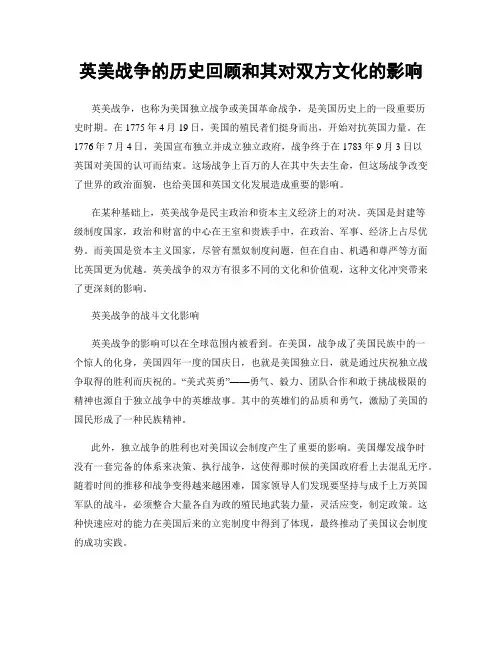
英美战争的历史回顾和其对双方文化的影响英美战争,也称为美国独立战争或美国革命战争,是美国历史上的一段重要历史时期。
在1775年4月19日,美国的殖民者们挺身而出,开始对抗英国力量。
在1776年7月4日,美国宣布独立并成立独立政府,战争终于在1783年9月3日以英国对美国的认可而结束。
这场战争上百万的人在其中失去生命,但这场战争改变了世界的政治面貌,也给美国和英国文化发展造成重要的影响。
在某种基础上,英美战争是民主政治和资本主义经济上的对决。
英国是封建等级制度国家,政治和财富的中心在王室和贵族手中,在政治、军事、经济上占尽优势。
而美国是资本主义国家,尽管有黑奴制度问题,但在自由、机遇和尊严等方面比英国更为优越。
英美战争的双方有很多不同的文化和价值观,这种文化冲突带来了更深刻的影响。
英美战争的战斗文化影响英美战争的影响可以在全球范围内被看到。
在美国,战争成了美国民族中的一个惊人的化身,美国四年一度的国庆日,也就是美国独立日,就是通过庆祝独立战争取得的胜利而庆祝的。
“美式英勇”——勇气、毅力、团队合作和敢于挑战极限的精神也源自于独立战争中的英雄故事。
其中的英雄们的品质和勇气,激励了美国的国民形成了一种民族精神。
此外,独立战争的胜利也对美国议会制度产生了重要的影响。
美国爆发战争时没有一套完备的体系来决策、执行战争,这使得那时候的美国政府看上去混乱无序。
随着时间的推移和战争变得越来越困难,国家领导人们发现要坚持与成千上万英国军队的战斗,必须整合大量各自为政的殖民地武装力量,灵活应变,制定政策。
这种快速应对的能力在美国后来的立宪制度中得到了体现,最终推动了美国议会制度的成功实践。
在英国,英美战争成为了大肆加强和保护殖民地的标志。
通过败北,英国失去了大片领土和经济利益,这让英国反思自己的殖民主义暴政,使得对殖民地的管理和力度以后得到关注。
同时,这场战争奠定了英国成为全球海上霸主的基础,英国与美国之间的互动逐渐转化为更为月域和经济上的合作,并为其后续在殖民地的影响奠定基础。
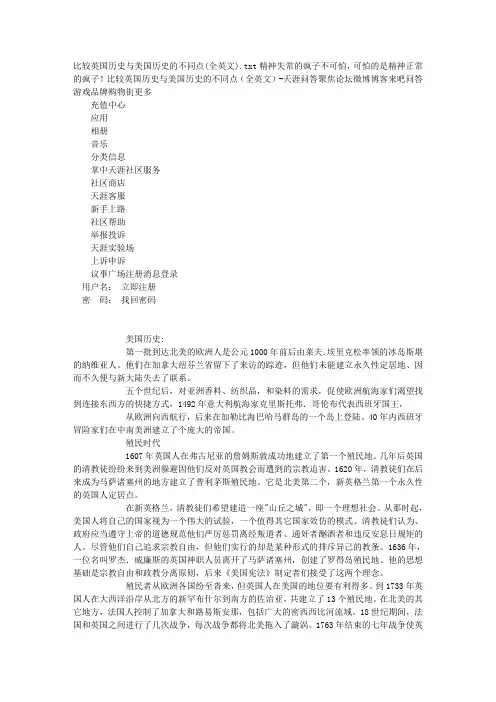
比较英国历史与美国历史的不同点(全英文).txt精神失常的疯子不可怕,可怕的是精神正常的疯子!比较英国历史与美国历史的不同点(全英文)-天涯问答聚焦论坛微博博客来吧问答游戏品牌购物街更多充值中心应用相册音乐分类信息掌中天涯社区服务社区商店天涯客服新手上路社区帮助举报投诉天涯实验场上诉申诉议事广场注册消息登录用户名:立即注册密码:找回密码美国历史:第一批到达北美的欧洲人是公元1000年前后由莱夫.埃里克松率领的冰岛斯堪的纳维亚人。
他们在加拿大纽芬兰省留下了来访的踪迹,但他们未能建立永久性定居地、因而不久便与新大陆失去了联系。
五个世纪后,对亚洲香料、纺织品,和染料的需求,促使欧洲航海家们渴望找到连接东西方的快捷方式,1492年意大利航海家克里斯托弗.哥伦布代表西班牙国王,从欧洲向西航行,后来在加勒比海巴哈马群岛的一个岛上登陆。
40年内西班牙冒险家们在中南美洲建立了个庞大的帝国。
殖民时代1607年英国人在弗古尼亚的詹姆斯敦成功地建立了第一个殖民地。
几年后英国的清教徒纷纷来到美洲躲避因他们反对英国教会而遭到的宗教迫害。
1620年,清教徒们在后来成为马萨诸塞州的地方建立了普利茅斯殖民地。
它是北美第二个,新英格兰第一个永久性的英国人定居点。
在新英格兰,清教徒们希望建造一座"山丘之城",即一个理想社会。
从那时起,美国人将自己的国家视为一个伟大的试验,一个值得其它国家效仿的模式。
清教徒们认为、政府应当遵守上帝的道德规范他们严厉惩罚离经叛道者、通奸者酗酒者和违反安息日规矩的人。
尽管他们自己追求宗教自由,但他们实行的却是某种形式的排斥异己的教条。
1636年,一位名叫罗杰.威廉斯的英国神职人员离开了马萨诸塞州,创建了罗得岛殖民地、他的思想基础是宗教自由和政教分离原则,后来《美国宪法》制定者们接受了这两个理念。
殖民者从欧洲各国纷至沓来,但英国人在美国的地位要有利得多。
到1733年英国人在大西洋沿岸从北方的新罕布什尔到南方的佐治亚,共建立了13个殖民地。

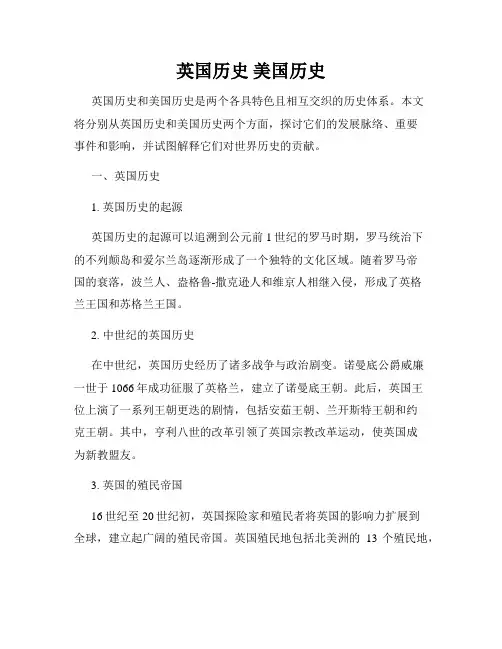
英国历史美国历史英国历史和美国历史是两个各具特色且相互交织的历史体系。
本文将分别从英国历史和美国历史两个方面,探讨它们的发展脉络、重要事件和影响,并试图解释它们对世界历史的贡献。
一、英国历史1. 英国历史的起源英国历史的起源可以追溯到公元前1世纪的罗马时期,罗马统治下的不列颠岛和爱尔兰岛逐渐形成了一个独特的文化区域。
随着罗马帝国的衰落,波兰人、盎格鲁-撒克逊人和维京人相继入侵,形成了英格兰王国和苏格兰王国。
2. 中世纪的英国历史在中世纪,英国历史经历了诸多战争与政治剧变。
诺曼底公爵威廉一世于1066年成功征服了英格兰,建立了诺曼底王朝。
此后,英国王位上演了一系列王朝更迭的剧情,包括安茹王朝、兰开斯特王朝和约克王朝。
其中,亨利八世的改革引领了英国宗教改革运动,使英国成为新教盟友。
3. 英国的殖民帝国16世纪至20世纪初,英国探险家和殖民者将英国的影响力扩展到全球,建立起广阔的殖民帝国。
英国殖民地包括北美洲的13个殖民地,印度次大陆和澳大利亚等地区。
这些殖民地成为英国的财富来源,并推动了英国工业革命的发展。
4. 英国历史中的重要事件英国历史中有许多重要事件对世界产生了深远的影响。
例如,英国爆发的玫瑰战争导致了王位的更迭,而这对英国历史后续的政治格局产生了重大影响。
此外,英国的大航海时代、工业革命和第一次世界大战等事件,在经济、社会和政治方面对世界有着重要的影响。
二、美国历史1. 美国历史的起源美国历史的起源可以追溯到17世纪初的殖民地时期。
最早的殖民地是在1620年建立的普利茅斯殖民地,其后又建立了其他殖民地,包括马萨诸塞湾殖民地和维吉尼亚殖民地。
这些殖民地逐渐形成了美国的基础结构。
2. 美国独立战争美国独立战争是美国历史中的一个里程碑事件。
1775年至1783年间,英国殖民地与大英帝国爆发了一场为争取独立而进行的战争。
最终,美国取得了胜利,于1783年签署《巴黎和约》获得独立。
3. 美国的西进运动19世纪中叶,美国经历了一个迅速扩张的时期,被称为西进运动。
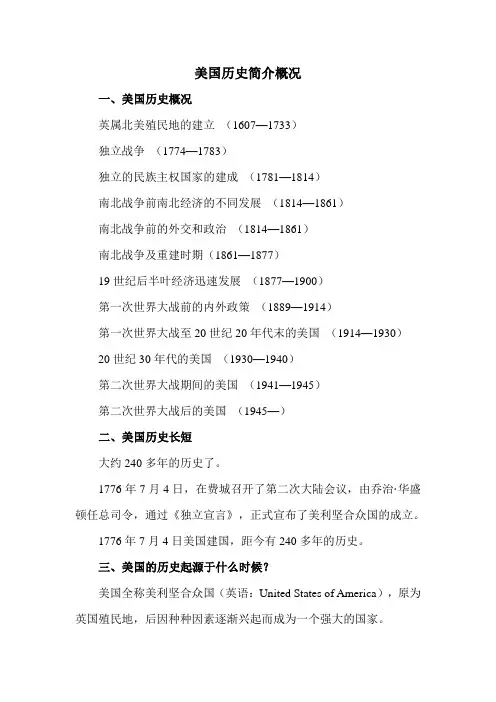
美国历史简介概况一、美国历史概况英属北美殖民地的建立(1607—1733)独立战争(1774—1783)独立的民族主权国家的建成(1781—1814)南北战争前南北经济的不同发展(1814—1861)南北战争前的外交和政治(1814—1861)南北战争及重建时期(1861—1877)19世纪后半叶经济迅速发展(1877—1900)第一次世界大战前的内外政策(1889—1914)第一次世界大战至20世纪20年代末的美国(1914—1930)20世纪30年代的美国(1930—1940)第二次世界大战期间的美国(1941—1945)第二次世界大战后的美国(1945—)二、美国历史长短大约240多年的历史了。
1776年7月4日,在费城召开了第二次大陆会议,由乔治·华盛顿任总司令,通过《独立宣言》,正式宣布了美利坚合众国的成立。
1776年7月4日美国建国,距今有240多年的历史。
三、美国的历史起源于什么时候?美国全称美利坚合众国(英语:United States of America),原为英国殖民地,后因种种因素逐渐兴起而成为一个强大的国家。
北美洲原始居民为印第安人。
16—18世纪,正在进行资本原始积累的西欧各国相继入侵北美洲。
到了十八世纪中期,在北美大西洋沿岸建立了十三块殖民地,殖民地的经济,文化,政治相对成熟。
但是殖民地与英国之间产生了裂痕,英国继续对北美地区采取高压政策,引起了北美地区居民强烈不满。
从1776年到1783年,北美十三州在华盛顿领导下取得了独立战争的胜利。
美国正式诞生,先后制定了一系列民主政治的法令。
逐步成为一个完全独立的民族主权国家。
殖民地时代从1607年到1733年,英国殖民者先后在北美洲东岸(大西洋沿岸)建立了十三个殖民地。
在十八世纪中期,殖民地的经济,文化,政治相对成熟,殖民地议会仍信奉英王乔治三世,不过他们追求与英国国会同等的地位,并不想成为英国的次等公民,但是此时英法的七年战争结束,急于巩固领土;向北美殖民地人民征收重税及英王乔治三世一改放任政策,主张高压手段。
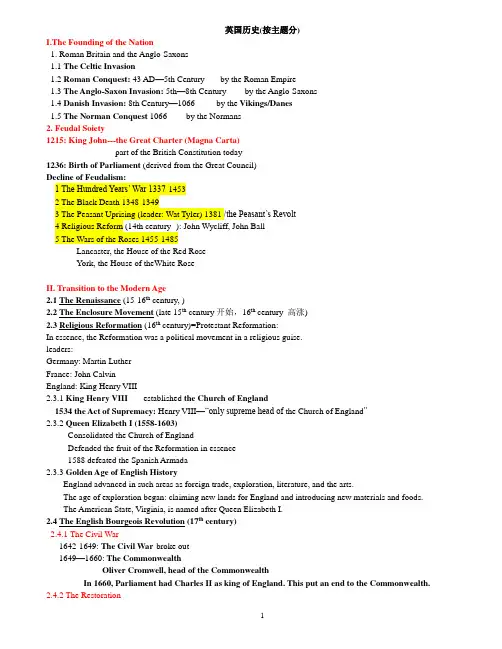
英国历史(按主题分)I.The Founding of the Nation1. Roman Britain and the Anglo-Saxons1.1 The Celtic Invasion1.2 Roman Conquest: 43 AD—5th Century ---- by the Roman Empire1.3 The Anglo-Saxon Invasion: 5th—8th Century----- by the Anglo-Saxons1.4 Danish Invasion: 8th Century—1066 ------ by the Vikings/Danes1.5 The Norman Conquest 1066 ------by the Normans2. Feudal Soiety1215: King John---the Great Charter (Magna Carta)part of the British Constitution today1236: Birth of Parliament (derived from the Great Council)Decline of Feudalism:1 The Hundred Years‘ War 1337-14532 The Black Death 1348-13493 The Peasant Uprising (leader: Wat Tyler) 1381 /the Peasant‘s Revolt4 Religious Reform (14th century- ): John Wycliff, John Ball5 The Wars of the Roses 1455-1485Lancaster, the House of the Red RoseYork, the House of theWhite RoseII. Transition to the Modern Age2.1The Renaissance (15-16th century, )2.2 The Enclosure Movement (late 15th century开始,16th century 高涨)2.3 Religious Reformation (16th century)=Protestant Reformation:In essence, the Reformation was a political movement in a religious guise.leaders:Germany: Martin LutherFrance: John CalvinEngland: King Henry VIII2.3.1 King Henry VIII ---- established the Church of England1534 the Act of Supremacy: Henry VIII—―only supreme head of the Church of England‖2.3.2 Queen Elizabeth I (1558-1603)Consolidated the Church of EnglandDefended the fruit of the Reformation in essence1588 defeated the Spanish Armada2.3.3 Golden Age of English HistoryEngland advanced in such areas as foreign trade, exploration, literature, and the arts.The age of exploration began: claiming new lands for England and introducing new materials and foods.The American State, Virginia, is named after Queen Elizabeth I.2.4 The English Bourgeois Revolution (17th century)2.4.1 The Civil War1642-1649: The Civil War broke out1649—1660: The CommonwealthOliver Cromwell, head of the CommonwealthIn 1660, Parliament had Charles II as king of England. This put an end to the Commonwealth.2.4.2 The Restoration1661, Charles II: to restore the old social order1685, James II: to reestablish Catholicism2.4.3 the Glorious Revolution1688: joint sovereign of William III and Mary II1689: Bill of Rights ---- established Constitutional Monarchy2.4 The Industrial Revolution (1750-1850)A series of important inventions in the textile industry marked the beginning of Industrial Revolution: Spinning JennyWater frameSpinning mulePower loomSteam engineIII. The Rise and Fall of the British Empire3.1 The Formation of the British Empire3.1.1. First British Empire: 19th CenturyIt included the colonies in Canada, Australia, New Zealand, India and many small states in the West Indies3.1.2. Second British Empire during the Victorian Age: Mid- and late-19th CenturyQueen Victoria’s foreign policy—New ImperialismIt included the colonies in Australia, New Zealand and Canada—dominions1876 Victoria—―Empress of India‖In Asia, occupied Burma and some other small states. Opium War against ChinaIn Africa, control Suez Canal and conquer EgyptUnion of South Africa—the 4th dominionOn the Eve of World War I, Britain had the largest colonial empire the world had ever seen.a territory of 33.5 million square kilometers (1/4 of the world‘s total land).a population of 393.5 million (8 times as large as that in Britain)3.2 Britain in the World Wars3.2.1 World War I (1914-1918)By the beginning of th e 20th century, Britain’s dominance was challenged by other European nations and the US. Two camps in Europe:Triple Alliance----the UK, France, Russia英,法,俄Triple Entente: 德,奥(匈帝国),意Central Powers: Germany, Austria-Hungary, Ottoman Empire and BulgariaAllied Powers: Britain, France, Russia, Italy and USThe immediate cause—assassination in SarajevoThe cost of the war for Britain was great:drained of its manpowerlost the sea supremacya huge national debtThe League of Nations was founded after WWI.3.2.2 World War II(1939-1945)Germany—plan to conquer EuropeBritain—appeasementdeclare war on Germany on September 3, 1939alliance with the Soviet Union and the United StatesGermany surrendered unconditionally on May 7, 1945great cost—lose its naval supremacy and in debt to the United States.UK's role in World War II:Germany: Hitler—plan to conquer Europe1Britain—appeasement(non-intervention) policy(Chamberlain administration 1937-1940)1938 UK and France signed Munich Agreement with Hitler2Winston Churchill:Prime Minister of the War Cabinet (1940-1945)The whole nation was mobilized1939.9.1 Germany‘s surprise attack of Polanddeclare war on Germany on September 3, 1939alliance with the Soviet Union and the United States: the Allies同盟国May, 1940 Great Retreat of Dunkirk (UK and France)敦刻尔克大撤退the Blitz: 闪电战August-November, 1940 German bombing raids in Great Britain1944 Allied forces landed in Normandy, France:Allied Armie s Normandy Landing(s)诺曼底登陆Germany surrendered unconditionally on May 7, 1945great cost—lose its naval supremacy and in debt to the United States.1945.10.24 The United Nations was founded3.3 The Fall of the Empire3.3.1 Independence movement—India, Pakistan, Burma, Malaya and Egypt3.3.2 British Commonwealth of Nations: 1931(a loosely organized community of former British colonies)4. Britain since World War II4.1. “Three Majestic Circles”4.1. 1One of the Big Three after WWII4.1. 2Foreign Policy: Three Majestic Circlesless involvement in the Commonwealth circleclose cooperation with the United Statesan isolationist policy towards Europe4.2 “Special Relationship” with the US4.2.1 Margaret ThatcherReestablished ―special relationship‖ with the United Statesagainst European integration4.2.2 Tony Blairmore positive towards Europe (but refuse to join the Euro)further strengthened the close relationship with the United States英国历史(按时间分)I. The decline of feudalism:the Hundred Years‘ War (1337-1453)百年战争the Black Death (1348-1350) 黑死病Religious Reform(14th Century- ) 宗教改革Wat Tyler‘s Uprising =Revolt/ the Peasants‘ Uprising (1381) 泰勒起义the Wars of the Roses (1455-1485) 玫瑰战争Henry Tudor都铎王朝the end of medieval England/feudalismII. 16th--- the rise of capitalism:Enclosure 圈地运动(15th-)the Renaissance文艺复兴III. 17th—: the English Bourgeois Revolution =Puritan Revolution/ the English Civil WarThe civil war broke out (1642—1649)Between the Royalists (the Cavalier [保王党人]) and Parliamentarians(Roundheads [圆颅党人])Result: the monarchy was abolished in 1949England was declared a commonwealth, i.e. a republicIV.18th____: the Industrial Revolution (1750-1850/1840)1733 John Kay---flying shuttle1765 James Hargreaves ----spinning jenny珍妮纺纱机1769 Richard Arkwright--- water frame水力纺纱机1769 James Watt ---steam engin改良蒸汽机results: the UK= workshop of the world;世界工厂the birth of the proletariat V.Chartist Movement (1836-1848)宪章运动VI. 19th---:From free enterprise to imperialismthe UK= workshop of the worldearliest colonial powers:Spain, Portugal, the Netherlands(17th )imperialism:1588: defeated Spain-- destroyed the Spanish Armada无敌舰队(Invincible Fleet)17th: defeated the Netherlands18th : defeated France英法四次争霸战争1688-1697-War of the League of Augsburg奥格斯堡联盟战争1701-1713 War of Spanish Succession西班牙王位继承战争1756-1763 the Seven Years‘ War英法七年战争1803-1815 the Napoleonic War 拿破仑战争(1805: The Battle of Trafalgar)(1815: the Battle of Waterloo)mid 19th: fefeated Russia1854-1856 the Crimean War克里米亚战争16th—19th:colonial expansion ---India, China, America, Africa (Elizabeth I,Victoria) 1583: New Foundland1607: Virginia1783: BahamaNew Zealand, China, India, BurmaVII. 1914-1918: World War I一战: 英国霸权地位的削弱,丧失霸主地位Triple Alliance----the UK, France, Russia英,法,俄Triple Entente: 德,奥(匈帝国),意VIII. 1939.9.1-1945.8.8: World War II 二战英帝国的急剧衰落英帝国的瓦解和英联邦(the Commonwealth 1931)的出现IX. Post WWII PeriodThe Cold War (1949-1989)50 Things You Need to Know About British History In date order:1.Stonehenge 2200 BC2.Roman Invasion and Civilisation 43 AD3.St Augustine and Christianity 5974.King Alfred the Great and the Doom Book 8715.Battle of Hastings and Norman Conquest 10666.Magna Carta and trial by jury 12157.Declaration of Arbroath 13208.Canterbury Tales 13709.Peasants’ Revolt 138110.The longbows at Agincourt 141511.Sir Francis Drake and the defeat of the Spanish Amrada 158812.Gunpowder Plot 160513.Shakespeare 161014.Plantation of Ulster 161115.Execution of Charles I 164916.Glorious Revolution (1688) and Bill of Rights (1689)17.Religious Settlement 155918.The Bank of England 169419.Act of Union 1707 (with Scotland)20.Britain’s first Prime Minister Robert Walpole 172121.Gin craze and British drink culture 172922.The East India Company and the Battle of Plassey 175723.Longitude 175924.Watt‘s Steam Engine 176925.Arkwright‘s Spinning Frame 177126.Adam Smith’s The Wealth of Nations 177627.The Siege of Yorktown and the loss of America 178128.Nelson‘s death and the Battle of Trafalgar 180529.William Wilberforce and the abolition of the slave trade 180730.Battle of Waterloo and national identity 181531.Sir Robert Peel and the British Bobby 182932.Factory Acts and the British weekend 185033.Dr Livingstone and Africa 185534.Charles Darwin and evolution 185935.The Red House and ‗my home is my castle‘ 185936.The laws of association football 186337.Suffragettes 191338.The Battle of the Somme 191639.The BBC 192740.Gandhi and Indian Independence 193141.The Blitz 194042.Frank Whittle and the jet engine 194143.The NHS and Welfare State 194844.SS Windrush and Multiculturalism 194845.The Beatles 196446.Monty Python and British humour 197147.Britain joins European Union 197348.Miners‘ strike and Mrs Thatcher 198449.The Channel Tunnel 199150.The Good Friday Agreement 1998History of the US(美国历史)I. America in the Colonial Era1.1 Plantation of 13 British colonies:1607 Virginia: by the London Company1620 Puritan New England: the Pilgrim FathersCatholic Maryland: by Calvert, the 2nd Lord Baltimore 1649Quaker Pensylvania 1681: by William Penn1.2 1773 Boston Tea Party1.3 1774 The First Continental CongressII. The War of Independence2.1 1775 The Gunshot of Lexington2.2 1775 The Second Continental Congress: Assume the functions of a national government2.3 July 4th, 1776: Declaration of IndependenceIII. The Establishment of the Constitution and federal government3.11787, the Constitution was drafted.1789, the Constitution came into effect in nine states.Federal government was founded, George Washington the 1st American president (1789-1797)3.21791 Ten amendments—The Bill of Rights—were added to the ConstitutionIV. the War of 1812 第二次美英战争US←→UK: the Second War of IndependenceV. Westward Expansion (1810s/1600s -1850s/1890s)●Florida: 1853, from SpainThe Oregon territory: 1846, from Britain●California: 1846, from Mexico (gold rush)●Alaska: 1867, from Russia●Hawaii: 1898, annexed Spanish-American War(1898)5.1 1823 the Monroe Doctrine:It later became a principle of US intervewntion whenever its national interesta were thereatened5.2 1836-1848 The Mexican-American WarVI. 1861-1865 The Civil War: Abraham Lincoln1863 the Gettsburg Address1863 The Emancipation Proclamation 《解放宣言》1865 the 13th amendment to the US Constitution, abolished slaveryVII. The Progressive Era (late 1800’s - early 1900’s ) 进步时代●A strong spirit of reform in the US●In response to problems raised by rapid industrialization and urbanization that followed the Civil War ●To protect their historic tradition of democratic government and universal economic opportunity Major themes●Concern for the underprivileged and downtrodden●The restoration of government to the rank and file●The enlargement of government power in order to bring industry and finance under popular controlSupport from three Presidents after 1900●President Theodore Roosevelt: establishment of the Bureau of Corporations (1903)●President Taft: furthering the cause of reform●President Wilson: flourishing of the reform movementVIII. The US Becomes a World Power8.1 Imperial Foreign Policy:Isolationism→ Interventionism●Before the 1890‘s: Isolationism 孤立主义●During the 1890‘s and 1900‘s: InterventionismBecoming a great power and an imperialistic countryA world power ready to assert its influence in international affairs8.21898: Spanish-American War8.3 1899 Open Door Policy: ChinaIX. The United States in the 20th century:9.1Theodore Roosevelt (1901-1909): “Big Stick” Policy9.2 The United States and World War I (1914-1918)•Allies—Britain, France, and Russia•The Central Powers—Germany, Austria-HungaryThe Treaty of Versailles (1919)President Wilson: Fourteen Points and the League of Nations(1920-1949)十四点计划和国际联盟9.3 The Post World War I Period1Isolation: a new one●The world‘s greatest manufacturing and exporting nation: Impossibility of total disengagement from world affairs2immigration●The end of free and open immigration in 1921●A significant change in attitude and legislation about immigration●Consequence: lessening the competitive and mobile character of American life3The booming 1920s: The Booming Economy in 1920‘s4Migration to the Cities: an urban nation5Women‘s Suffrage6 The Great Depression --1930s (1929- )Franklin Roosevelt–the ―New Deal‖9.4 The United States and World War II (1939-1945)1Isolation and Neutrality: A sit-on-the-fence policy2America Enters the War (1941-1945)•December 7, 1941, Pearl Harbor,Conference at Potsdam3End of WWII▪The US airforce dropped atomic bombs on Hiroshima On August 6 and on Nagasaki on August 8.▪On September 2, 1945, Japan surrendered.Results of World War II●Enhanced military and economic power: the only nation that benefited from the war●The Baby Boom 1946-1964●Establishment of the UN (1945.10.24)9.5The Cold War (1945-1989)1United Nations in 1945—a new and better world would emerge from World War II.2The conflict between the two superpowers Russia and the US increased and later led to the Cold War.3President Truman: 1947 the Containment PolicyGeorge Marshal: 1947 The Marshall Plan4the United States – 1949 NATO (the North Atlantic Treaty Organization)1955, the Soviet Union -- Warsaw Pact5the Korean War (1950-1953)6The Red Scare and McCarthyism赤色恐慌和麦卡锡主义A modern witch hunt for communists from 1951 to 1954 政治迫害7John Kennedy and the Cuban Missile Crisis 古巴导弹危机8The Vietnam War (1954/1961-1973/1975)9Richard Nixon and Détente国际紧张关系的缓和Two other diplomatic breakthroughs:1979 Re-establ ishing US relations with the People‘s Republic of ChinaNegotiating the first Strategic Arms Limitation Treaty with the Soviet Union•Table Tennis Foreign Policy•Nixon–first US president visited Beijing.•The ―Shanghai Communiqué‖—a new US policy:–there was one China;–Taiwan was part of China;–a peaceful settlement of the dispute by the Chinese themselves was in American interest.–The Watergate Scandal 水门事件: Richard Nixon‘s resignation in August,197410Ronald Regan: the Star Wars Project9.6 Social Movements in the 1960sThe Civil Rights Movement 民权运动The Youth (Anti-war) Movement: Counter Culture 青年文化/ 反传统文化Women’s Rights Movement9.7 George Bush(1989-92): The Persian Gulf War (Gulf War)1990: Iraq occupied and annexed Kuwait9.8 Bill Clinton (1992-2000): Engagement and expansion3 pillars of US foreign policy---national security, economic prosperity, promotion of democracyKosovo CrisisX. America in the 21st Century10.1 George W. Bush(2001-2009): Unilateralism and faith in military strength1The war against terrorismTerrorist Event on September 11, 20012Invasion of Iraq (March 19, 2003)•―Trial of century‖—the trial of Saddam began on October, 19, 2005 in Baghdad.•Saddam is accused of crimes against humanity.10.2 Barrack Obama(2009- ): DemocraticChallenges:Economic turmoil, unpopular unjustifiable war (the war in Afghanistan, in Iraq), time of changes。
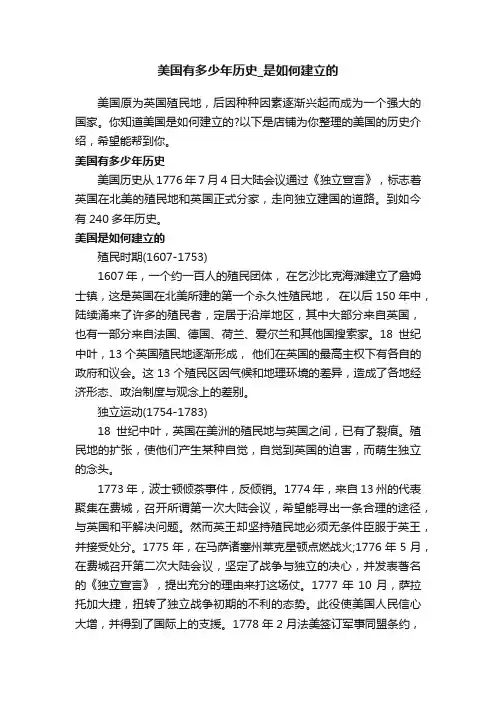
美国有多少年历史_是如何建立的美国原为英国殖民地,后因种种因素逐渐兴起而成为一个强大的国家。
你知道美国是如何建立的?以下是店铺为你整理的美国的历史介绍,希望能帮到你。
美国有多少年历史美国历史从1776年7月4日大陆会议通过《独立宣言》,标志着英国在北美的殖民地和英国正式分家,走向独立建国的道路。
到如今有240多年历史。
美国是如何建立的殖民时期(1607-1753)1607年,一个约一百人的殖民团体,在乞沙比克海滩建立了詹姆士镇,这是英国在北美所建的第一个永久性殖民地,在以后150年中,陆续涌来了许多的殖民者,定居于沿岸地区,其中大部分来自英国,也有一部分来自法国、德国、荷兰、爱尔兰和其他国搜索家。
18世纪中叶,13个英国殖民地逐渐形成,他们在英国的最高主权下有各自的政府和议会。
这13个殖民区因气候和地理环境的差异,造成了各地经济形态、政治制度与观念上的差别。
独立运动(1754-1783)18世纪中叶,英国在美洲的殖民地与英国之间,已有了裂痕。
殖民地的扩张,使他们产生某种自觉,自觉到英国的迫害,而萌生独立的念头。
1773年,波士顿倾茶事件,反倾销。
1774年,来自13州的代表聚集在费城,召开所谓第一次大陆会议,希望能寻出一条合理的途径,与英国和平解决问题。
然而英王却坚持殖民地必须无条件臣服于英王,并接受处分。
1775年,在马萨诸塞州莱克星顿点燃战火;1776年5月,在费城召开第二次大陆会议,坚定了战争与独立的决心,并发表著名的《独立宣言》,提出充分的理由来打这场仗。
1777年10月,萨拉托加大捷,扭转了独立战争初期的不利的态势。
此役使美国人民信心大增,并得到了国际上的支援。
1778年2月法美签订军事同盟条约,法国正式承认美国。
法国、西班牙、荷兰相继参战。
1781年,约克城战役大捷,美军赢得决定性的胜利。
约克敦战役后,除了海上尚有几次交战和陆上的零星战斗外,北美大陆战事已基本停止。
1782年11月30日,英美签署《巴黎和约》草案,1783年9月3日,英国正式承认美国独立。
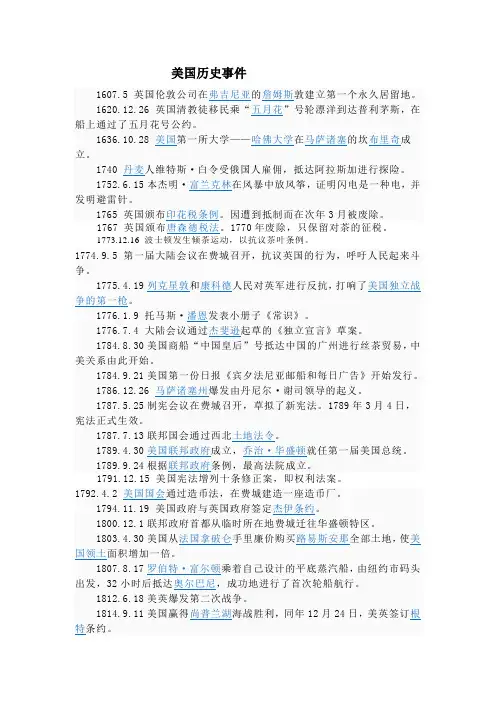
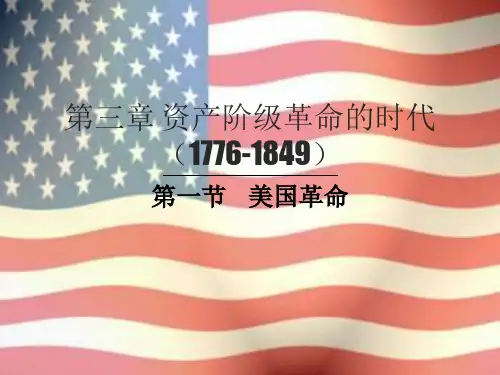
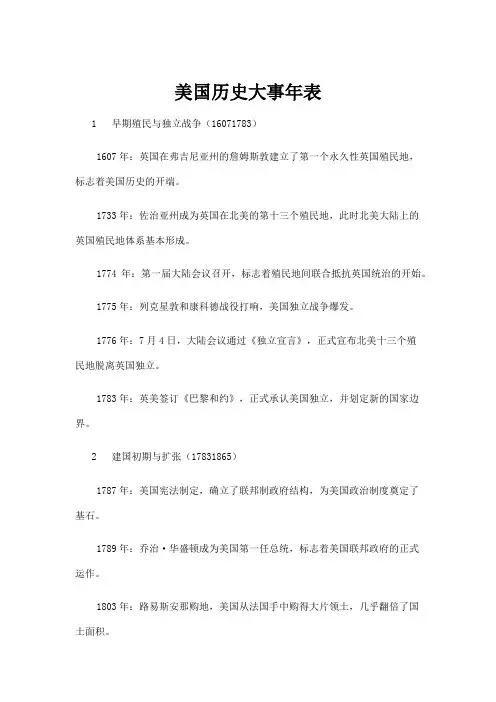
美国历史大事年表1️⃣ 早期殖民与独立战争(16071783)1607年:英国在弗吉尼亚州的詹姆斯敦建立了第一个永久性英国殖民地,标志着美国历史的开端。
1733年:佐治亚州成为英国在北美的第十三个殖民地,此时北美大陆上的英国殖民地体系基本形成。
1774年:第一届大陆会议召开,标志着殖民地间联合抵抗英国统治的开始。
1775年:列克星敦和康科德战役打响,美国独立战争爆发。
1776年:7月4日,大陆会议通过《独立宣言》,正式宣布北美十三个殖民地脱离英国独立。
1783年:英美签订《巴黎和约》,正式承认美国独立,并划定新的国家边界。
2️⃣ 建国初期与扩张(17831865)1787年:美国宪法制定,确立了联邦制政府结构,为美国政治制度奠定了基石。
1789年:乔治·华盛顿成为美国第一任总统,标志着美国联邦政府的正式运作。
1803年:路易斯安那购地,美国从法国手中购得大片领土,几乎翻倍了国土面积。
1812年:美英第二次战争,虽然战争规模不大,但加强了美国的国家认同感。
18201850年:西进运动,美国向西部扩张,引发了一系列领土争端和种族冲突。
18611865年:美国南北战争,以北方胜利告终,废除了奴隶制,维护了国家统一。
3️⃣ 现代化与全球影响(1865至今)1865年:南北战争结束,美国进入重建时期,努力解决战后遗留的社会问题。
18901920年:工业革命与镀金时代,美国经济迅速发展,但也伴随着贫富差距的扩大和社会矛盾的加剧。
1917年:美国参加第一次世界大战,战后成为世界上最强大的经济大国之一。
19291933年:大萧条,美国经济遭受重创,罗斯福新政实施,标志着美国政府开始积极干预经济。
19411945年:第二次世界大战,美国作为盟军主力之一,对战争的胜利起到了关键作用。
1945年至今:冷战时期,美国与苏联展开全球范围内的政治、经济和军事竞争;冷战结束后,美国成为唯一的超级大国,积极参与全球事务,推动全球化进程。
1.美国独立战争(1775年—1783年),一开始是主要发生于大英帝国和其北美十三州殖民地的革命者之间的一场战争。
这场战争主要是始于为了对抗英国的经济政策,但后来却因为法国、西班牙及荷兰加入战争对抗英国,而使战争的范围远远超过了英属北美洲之外。
同时,许多印地安人为双方打仗。
但其实根据北美历史的记载,在战争爆发之前,英国已经取消了大部分施加在北美殖民地人民身上的税,对于其殖民地的运营,英国政府实际上已经处于经济亏损状态。
而美国的独立原因也并不简单,英国历史学家的普遍看法是,在18世纪末,奴隶制度在英国本土已经饱受诟病,面临取缔,从19世纪开始,英国政府授权皇家海军可以攻击任何一艘被怀疑卷入奴隶贸易的海上商船,再加上英国允诺北美十三州的印第安人以大片的自治土地,这些因素对殖民北美的大奴隶主造成沉重的打击,而引起他们对英国政府的强烈不满。
战争开始后,英国政府宣布与英国一同作战的黑奴可以获得人身自由,因此大批黑奴逃入加拿大的英国人控制区。
从七年战争开始,英国人与北美的印第安人便缔结了同盟关系,尤其是纽约附近的莫霍克印第安人,在英国战败后遭到美国新政府的残酷报复,他们被驱逐至五大湖附近,在西进运动中又再一次被迫西迁。
美国独立战争本质上是北美的原英国殖民者同英国中央政府因利益冲突而发生内讧,并进而决裂的结果;而通过战争独立出来的美利坚合众国本身恰恰就是盎格鲁撒克逊北美殖民统治的延续。
反抗英皇统治自英国开发海外殖民地以来,为了维护英国本土的垄断利益,颁布了一些限制殖民地经济发展的法令,例如《航海条例》。
随着北美殖民地自身发展,殖民者们越来越希望减低对英国本土的依赖,寻求独立发展其自身的经济。
然而,这却引起了英国当局的不满,因为英国当局希望北美殖民地能继续充当其廉价的原材料供应地及商品倾销的市场,因此,英国当局开始采取很多高压政策以阻遏殖民地经挤的自由发展。
英国当局首先颁布法令,不准其下的北美殖民者向西开拓,并禁止其私自发行另类纸币,再对其课以重税及解散其议会,这使得北美殖民势力感到强烈不满,并发动了大规模的游行示威。
美国和英国历史上发生过的战争如果英法战争的结果是法胜英败,或打成平手, 北美历史就得重写了。
美国和英国历史上发生过多少次战争?本文是店铺整理美国和英国历史上发生过的战争的资料,仅供参考。
美国和英国历史上发生过的战争美国革命战争(英语:American Revolutionary War),是大英帝国和其十三殖民地殖民地,以及几个欧洲强国之间的一场战争。
1776年7月2日宣布13个殖民地脱离英国独立,7月4日通过了《独立宣言》从1775年4月至1777年10月,是北美殖民地的战略防御阶段。
在这一阶段,北部地区为主要战场,英军采取主动攻势。
1775年6月17日,英军与波士顿民兵在碉堡山战役进行首次战斗。
从1777年10月至1781年3月,双方进入战略相持阶段。
美国开始在国际外交上获得优势,法国、西班牙、荷兰亦相继加入战争,协助美军对抗英军。
1778年2月,法国正式承认美国,并与其互订军事同盟。
1781年4月至1783年9月,是美军的战略反攻阶段。
1781年4月大陆军开始战略反攻,纳撒尼尔·格林率领大陆军南下转战南卡罗来纳,迫使英军退守海岸线。
约克镇围城战役之後,英国议会被迫赞成议和,1782年11月30日,英美两国签署《巴黎和约》的草案,1783年9月3日,美国成为美洲首个独立国家。
1812年战争,又称第二次独立战争,是美国与英国之间发生於1812至1815年的战争。
是美国独立後第一次对外战争。
1812年6月18日,美国向英国宣战。
1812至1813年,美国攻击英国北美殖民地加拿大各省。
1813年10月至1814年3月,英国在欧洲击败拿破仑,将更多的兵力增援北美战场。
英国占领美国的缅因州,并且一度攻占美国首都华盛顿。
但是英国陆军在美国南部的路易斯安那州战场、尚普兰湖战役、巴尔地摩战役、纽奥良战役中多次遭到挫败,并且海军也遭受败局。
1815年双方停战,边界恢复原状。
英美战争1811年,美国众议院的鹰派议员鼓动战争。
美国和英国的历史对比一、美国和英国历史上有何关系美国的领土扩张,从建国到1898年,通过购买、移民、战争等手段,夺取了从大西洋东岸到太平洋西岸的大片土地。
美国的领土是独立前由13个殖民地扩张的51个州940万平方公里。
美国的领土扩张1776年7月4日,北美13个殖民地宣布脱离英国独立。
此时,美国领土只有大西洋沿岸13个州的面积,约80万平方公里。
1783年,英国承认美国独立,并先后把13个州以外大西洋沿岸的大部分土地划归美国,美国领土达到230万平方公里,约占现在美国本土面积的30%。
1789年,美国联邦 *** 成立。
刚刚成立的美国很快就走上了领土扩张的道路,除了用战争,金钱成了获得领土最常用的方式。
二、英国和美国的关系为什么那么好一个是曾经的世界霸主,一个是现在的世界霸主,现在英国不得不紧跟美国。
他们可以说是他是我的兄弟。
虽然有一些国家和他们结盟,也就是现在的北约,但是有多少是为美国服务的呢?在北约,除了美国,其他都是壁花。
如果美国失败了,大家又开始跳槽了。
所以,美国其实是孤独的。
英国比美国好。
大部分原因是利益太大。
中东的石油世界在很多方面都需要美国的帮助,美国一个人做不到。
总要有一个朋友和他一起承担重担。
所以,英国被选中了。
法国太不听话了。
德国在世界上太认真了,不配和美国做朋友,只有中国才配和美国做朋友。
不会吧。
三、【英国.法国,美国的主要矛盾和关系是什么一楼的不懂不要想当然,中国与欧洲,美国万里之遥,很多事情在中国大陆的主流民意中,有错的很理谱的误区,所以不要误导楼主.小弟是伦顿大学SOAS国际关系大二在读,简单的说一下,不一定很完整,但不至于错.首先,今天的西方世界主要分为两大阵营,一:以美国为首,英国日本为辅助,加拿大,澳大利亚等国为环绕的"大西洋轴心"(Atlanticist Axis)二:以法国为首,德国为辅,绝大多数欧洲大陆国家为环绕的"法德联盟"(Franco-Germany Coalition)英国是与美国关系最为密切的国家,今日世界的大多数秩序,尤其如地缘政治,经济,等等,均由旧大英帝国在19世纪末 - 20世纪初一手塑造,并于20世纪中期转交于美国,以继续完善对西方自由主义有利的金融秩序等等.因此,20世纪的世界秩序在西方又被称为"英美世界新秩序"(Anglo-American New World Order)英国与美国在80年代中期确认了"英美特殊关系"(British-American Special Relationship),在"英美特殊关系"的保护下,英美两国可以享有在对方国家独一无二的市场及金融特权,"英美特殊关系"也同样确保了英美两国军事科技的高级互换通道.除了国家利益的高度吻合,英美两国同时拥有高度吻合的文化,价值观等等,因此,英美两国的关系,用"骨肉相连"来形容,并不过分.法国虽然在经济总量上排在英,德之后,但由于历史的原因,法国拥有很多独一无二的"通道",可以暗中操纵欧盟,因此法国是欧洲大陆政治权力最为强大的国家,用英国前外交大臣米德李班的话说:"整个欧盟就像是法国的后院".同时,法国是欧盟一体化最为主要的推动者,这一政策方针在根本上伤害了英国的国家利益,并威胁了美国的世界霸主地位.简而言之,在欧洲,美国一直在利用英国制约法国,而英国也同时在利用和美国高度亲密的关系以维持英国在西欧强大的政治,经济,及金融实力.而法国则一直在利用自身暗中掌握欧洲大陆的筹码,制约英美.但由于英国毕竟是欧盟成员国,同时自身实力较强大,因此法国一直对英国有拉拢的姿态,但同时法国又不愿英国在欧洲过于强大,以免威胁自身"欧洲联盟领军"的地位.相比暧昧中带有冷漠的英法关系,法国与美国的关系则较为恶劣.法国与美国在很多国际事务中常年明争暗斗,如在非洲事务,国际金融秩序,乃至文化领域.但无论如何,法国与美国的芥蒂纵使再深,法,美两国毕竟还都属于"西方国家"这一大的整体,在面临*** ,俄罗斯的重新军事化,和崛起中的中国,这一类外部环境的"共同敌人"的时候,通常法美两国还是能够肩并肩的站在一起.。
美国历史的建国与发展美国作为世界上最大的经济强国之一,其建国与发展的历程充满了许多值得研究的内容。
从殖民地时期的殖民地开拓到独立战争的胜利,再到建国后的国家建设和西部拓荒运动,美国历史的建国与发展可以说是举世瞩目。
一、殖民地开拓与移民潮17世纪初,北美洲的东海岸地区开始有英国、荷兰和法国等欧洲国家的殖民地开拓者涌入。
他们在当地建立了许多殖民地,如弗吉尼亚殖民地和麻省湾殖民地等。
这些欧洲人的移民潮为美国的建国与发展奠定了基础。
二、独立战争与独立宣言1765年至1783年间,美国爆发了独立战争。
由于英国政府过度征税和限制殖民地的自由,殖民地居民开始反抗英国的统治。
1776年,美国大陆会议通过了独立宣言,正式宣布脱离英国独立。
这场独立战争的胜利,为美国的建国与发展奠定了基础。
三、宪法制定与美国政府建设1787年,美国成立了制宪会议,起草了美国宪法。
美国宪法规定了联邦制度和三权分立的原则,确立了政府的权力和职责,为美国政府的建设奠定了基础。
此后,美国逐渐完善了自己的政治制度和法律体系,确立了代表民主制度的政府形式。
四、西部拓荒与移民潮19世纪初,美国经历了一系列的西部拓荒运动。
这个时期,美国国内的人口迅速增长,许多移民潮涌入西部地区。
这场西部拓荒运动推动了美国国土的扩张,也促进了美国的工业和经济发展。
五、南北战争与解放黑奴19世纪40年代到60年代,美国爆发了南北战争。
战争的原因是南部地区经济以奴隶制度为基础,而北部地区则反对奴隶制度。
最终,北方获得了胜利,奴隶制度被废除。
这场战争对美国历史的建国与发展产生了深远的影响,确立了美国现代化的发展方向。
六、美国的工业化与现代化19世纪末至20世纪初,美国经历了工业化和现代化的进程。
这个时期,美国的工业发展迅猛,特别是在石油、钢铁和电力等领域取得了巨大的成就。
同时,美国社会也发生了巨大的变化,城市化和现代化的发展成为主流。
结语美国历史的建国与发展是一个充满曲折和辉煌的历程。
英国历史(按主题分)I.The Founding of the Nation1. Roman Britain and the Anglo-Saxons1.1 The Celtic Invasion1.2 Roman Conquest: 43 AD—5th Century ---- by the Roman Empire1.3 The Anglo-Saxon Invasion: 5th—8th Century----- by the Anglo-Saxons1.4 Danish Invasion: 8th Century—1066 ------ by the Vikings/Danes1.5 The Norman Conquest 1066 ------by the Normans2. Feudal Soiety1215: King John---the Great Charter (Magna Carta)part of the British Constitution today1236: Birth of Parliament (derived from the Great Council)Decline of Feudalism:1 The Hundred Years‘ War 1337-14532 The Black Death 1348-13493 The Peasant Uprising (leader: Wat Tyler) 1381 /the Peasant‘s Revolt4 Religious Reform (14th century- ): John Wycliff, John Ball5 The Wars of the Roses 1455-1485Lancaster, the House of the Red RoseYork, the House of theWhite RoseII. Transition to the Modern Age2.1The Renaissance (15-16th century, )2.2 The Enclosure Movement (late 15th century开始,16th century 高涨)2.3 Religious Reformation (16th century)=Protestant Reformation:In essence, the Reformation was a political movement in a religious guise.leaders:Germany: Martin LutherFrance: John CalvinEngland: King Henry VIII2.3.1 King Henry VIII ---- established the Church of England1534 the Act of Supremacy: Henry VIII—―only supreme head of the Church of England‖2.3.2 Queen Elizabeth I (1558-1603)Consolidated the Church of EnglandDefended the fruit of the Reformation in essence1588 defeated the Spanish Armada2.3.3 Golden Age of English HistoryEngland advanced in such areas as foreign trade, exploration, literature, and the arts.The age of exploration began: claiming new lands for England and introducing new materials and foods.The American State, Virginia, is named after Queen Elizabeth I.2.4 The English Bourgeois Revolution (17th century)2.4.1 The Civil War1642-1649: The Civil War broke out1649—1660: The CommonwealthOliver Cromwell, head of the CommonwealthIn 1660, Parliament had Charles II as king of England. This put an end to the Commonwealth.2.4.2 The Restoration1661, Charles II: to restore the old social order1685, James II: to reestablish Catholicism2.4.3 the Glorious Revolution1688: joint sovereign of William III and Mary II1689: Bill of Rights ---- established Constitutional Monarchy2.4 The Industrial Revolution (1750-1850)A series of important inventions in the textile industry marked the beginning of Industrial Revolution: Spinning JennyWater frameSpinning mulePower loomSteam engineIII. The Rise and Fall of the British Empire3.1 The Formation of the British Empire3.1.1. First British Empire: 19th CenturyIt included the colonies in Canada, Australia, New Zealand, India and many small states in the West Indies3.1.2. Second British Empire during the Victorian Age: Mid- and late-19th CenturyQueen Victoria’s foreign policy—New ImperialismIt included the colonies in Australia, New Zealand and Canada—dominions1876 Victoria—―Empress of India‖In Asia, occupied Burma and some other small states. Opium War against ChinaIn Africa, control Suez Canal and conquer EgyptUnion of South Africa—the 4th dominionOn the Eve of World War I, Britain had the largest colonial empire the world had ever seen.a territory of 33.5 million square kilometers (1/4 of the world‘s total land).a population of 393.5 million (8 times as large as that in Britain)3.2 Britain in the World Wars3.2.1 World War I (1914-1918)By the beginning of th e 20th century, Britain’s dominance was challenged by other European nations and the US. Two camps in Europe:Triple Alliance----the UK, France, Russia英,法,俄Triple Entente: 德,奥(匈帝国),意Central Powers: Germany, Austria-Hungary, Ottoman Empire and BulgariaAllied Powers: Britain, France, Russia, Italy and USThe immediate cause—assassination in SarajevoThe cost of the war for Britain was great:drained of its manpowerlost the sea supremacya huge national debtThe League of Nations was founded after WWI.3.2.2 World War II(1939-1945)Germany—plan to conquer EuropeBritain—appeasementdeclare war on Germany on September 3, 1939alliance with the Soviet Union and the United StatesGermany surrendered unconditionally on May 7, 1945great cost—lose its naval supremacy and in debt to the United States.UK's role in World War II:Germany: Hitler—plan to conquer Europe1Britain—appeasement(non-intervention) policy(Chamberlain administration 1937-1940)1938 UK and France signed Munich Agreement with Hitler2Winston Churchill:Prime Minister of the War Cabinet (1940-1945)The whole nation was mobilized1939.9.1 Germany‘s surprise attack of Polanddeclare war on Germany on September 3, 1939alliance with the Soviet Union and the United States: the Allies同盟国May, 1940 Great Retreat of Dunkirk (UK and France)敦刻尔克大撤退the Blitz: 闪电战August-November, 1940 German bombing raids in Great Britain1944 Allied forces landed in Normandy, France:Allied Armie s Normandy Landing(s)诺曼底登陆Germany surrendered unconditionally on May 7, 1945great cost—lose its naval supremacy and in debt to the United States.1945.10.24 The United Nations was founded3.3 The Fall of the Empire3.3.1 Independence movement—India, Pakistan, Burma, Malaya and Egypt3.3.2 British Commonwealth of Nations: 1931(a loosely organized community of former British colonies)4. Britain since World War II4.1. “Three Majestic Circles”4.1. 1One of the Big Three after WWII4.1. 2Foreign Policy: Three Majestic Circlesless involvement in the Commonwealth circleclose cooperation with the United Statesan isolationist policy towards Europe4.2 “Special Relationship” with the US4.2.1 Margaret ThatcherReestablished ―special relationship‖ with the United Statesagainst European integration4.2.2 Tony Blairmore positive towards Europe (but refuse to join the Euro)further strengthened the close relationship with the United States英国历史(按时间分)I. The decline of feudalism:the Hundred Years‘ War (1337-1453)百年战争the Black Death (1348-1350) 黑死病Religious Reform(14th Century- ) 宗教改革Wat Tyler‘s Uprising =Revolt/ the Peasants‘ Uprising (1381) 泰勒起义the Wars of the Roses (1455-1485) 玫瑰战争Henry Tudor都铎王朝the end of medieval England/feudalismII. 16th--- the rise of capitalism:Enclosure 圈地运动(15th-)the Renaissance文艺复兴III. 17th—: the English Bourgeois Revolution =Puritan Revolution/ the English Civil WarThe civil war broke out (1642—1649)Between the Royalists (the Cavalier [保王党人]) and Parliamentarians(Roundheads [圆颅党人])Result: the monarchy was abolished in 1949England was declared a commonwealth, i.e. a republicIV.18th____: the Industrial Revolution (1750-1850/1840)1733 John Kay---flying shuttle1765 James Hargreaves ----spinning jenny珍妮纺纱机1769 Richard Arkwright--- water frame水力纺纱机1769 James Watt ---steam engin改良蒸汽机results: the UK= workshop of the world;世界工厂the birth of the proletariat V.Chartist Movement (1836-1848)宪章运动VI. 19th---:From free enterprise to imperialismthe UK= workshop of the worldearliest colonial powers:Spain, Portugal, the Netherlands(17th )imperialism:1588: defeated Spain-- destroyed the Spanish Armada无敌舰队(Invincible Fleet)17th: defeated the Netherlands18th : defeated France英法四次争霸战争1688-1697-War of the League of Augsburg奥格斯堡联盟战争1701-1713 War of Spanish Succession西班牙王位继承战争1756-1763 the Seven Years‘ War英法七年战争1803-1815 the Napoleonic War 拿破仑战争(1805: The Battle of Trafalgar)(1815: the Battle of Waterloo)mid 19th: fefeated Russia1854-1856 the Crimean War克里米亚战争16th—19th:colonial expansion ---India, China, America, Africa (Elizabeth I,Victoria) 1583: New Foundland1607: Virginia1783: BahamaNew Zealand, China, India, BurmaVII. 1914-1918: World War I一战: 英国霸权地位的削弱,丧失霸主地位Triple Alliance----the UK, France, Russia英,法,俄Triple Entente: 德,奥(匈帝国),意VIII. 1939.9.1-1945.8.8: World War II 二战英帝国的急剧衰落英帝国的瓦解和英联邦(the Commonwealth 1931)的出现IX. Post WWII PeriodThe Cold War (1949-1989)50 Things You Need to Know About British History In date order:1.Stonehenge 2200 BC2.Roman Invasion and Civilisation 43 AD3.St Augustine and Christianity 5974.King Alfred the Great and the Doom Book 8715.Battle of Hastings and Norman Conquest 10666.Magna Carta and trial by jury 12157.Declaration of Arbroath 13208.Canterbury Tales 13709.Peasants’ Revolt 138110.The longbows at Agincourt 141511.Sir Francis Drake and the defeat of the Spanish Amrada 158812.Gunpowder Plot 160513.Shakespeare 161014.Plantation of Ulster 161115.Execution of Charles I 164916.Glorious Revolution (1688) and Bill of Rights (1689)17.Religious Settlement 155918.The Bank of England 169419.Act of Union 1707 (with Scotland)20.Britain’s first Prime Minister Robert Walpole 172121.Gin craze and British drink culture 172922.The East India Company and the Battle of Plassey 175723.Longitude 175924.Watt‘s Steam Engine 176925.Arkwright‘s Spinning Frame 177126.Adam Smith’s The Wealth of Nations 177627.The Siege of Yorktown and the loss of America 178128.Nelson‘s death and the Battle of Trafalgar 180529.William Wilberforce and the abolition of the slave trade 180730.Battle of Waterloo and national identity 181531.Sir Robert Peel and the British Bobby 182932.Factory Acts and the British weekend 185033.Dr Livingstone and Africa 185534.Charles Darwin and evolution 185935.The Red House and ‗my home is my castle‘ 185936.The laws of association football 186337.Suffragettes 191338.The Battle of the Somme 191639.The BBC 192740.Gandhi and Indian Independence 193141.The Blitz 194042.Frank Whittle and the jet engine 194143.The NHS and Welfare State 194844.SS Windrush and Multiculturalism 194845.The Beatles 196446.Monty Python and British humour 197147.Britain joins European Union 197348.Miners‘ strike and Mrs Thatcher 198449.The Channel Tunnel 199150.The Good Friday Agreement 1998History of the US(美国历史)I. America in the Colonial Era1.1 Plantation of 13 British colonies:1607 Virginia: by the London Company1620 Puritan New England: the Pilgrim FathersCatholic Maryland: by Calvert, the 2nd Lord Baltimore 1649Quaker Pensylvania 1681: by William Penn1.2 1773 Boston Tea Party1.3 1774 The First Continental CongressII. The War of Independence2.1 1775 The Gunshot of Lexington2.2 1775 The Second Continental Congress: Assume the functions of a national government2.3 July 4th, 1776: Declaration of IndependenceIII. The Establishment of the Constitution and federal government3.11787, the Constitution was drafted.1789, the Constitution came into effect in nine states.Federal government was founded, George Washington the 1st American president (1789-1797)3.21791 Ten amendments—The Bill of Rights—were added to the ConstitutionIV. the War of 1812 第二次美英战争US←→UK: the Second War of IndependenceV. Westward Expansion (1810s/1600s -1850s/1890s)●Florida: 1853, from SpainThe Oregon territory: 1846, from Britain●California: 1846, from Mexico (gold rush)●Alaska: 1867, from Russia●Hawaii: 1898, annexed Spanish-American War(1898)5.1 1823 the Monroe Doctrine:It later became a principle of US intervewntion whenever its national interesta were thereatened5.2 1836-1848 The Mexican-American WarVI. 1861-1865 The Civil War: Abraham Lincoln1863 the Gettsburg Address1863 The Emancipation Proclamation 《解放宣言》1865 the 13th amendment to the US Constitution, abolished slaveryVII. The Progressive Era (late 1800’s - early 1900’s ) 进步时代●A strong spirit of reform in the US●In response to problems raised by rapid industrialization and urbanization that followed the Civil War ●To protect their historic tradition of democratic government and universal economic opportunity Major themes●Concern for the underprivileged and downtrodden●The restoration of government to the rank and file●The enlargement of government power in order to bring industry and finance under popular controlSupport from three Presidents after 1900●President Theodore Roosevelt: establishment of the Bureau of Corporations (1903)●President Taft: furthering the cause of reform●President Wilson: flourishing of the reform movementVIII. The US Becomes a World Power8.1 Imperial Foreign Policy:Isolationism→ Interventionism●Before the 1890‘s: Isolationism 孤立主义●During the 1890‘s and 1900‘s: InterventionismBecoming a great power and an imperialistic countryA world power ready to assert its influence in international affairs8.21898: Spanish-American War8.3 1899 Open Door Policy: ChinaIX. The United States in the 20th century:9.1Theodore Roosevelt (1901-1909): “Big Stick” Policy9.2 The United States and World War I (1914-1918)•Allies—Britain, France, and Russia•The Central Powers—Germany, Austria-HungaryThe Treaty of Versailles (1919)President Wilson: Fourteen Points and the League of Nations(1920-1949)十四点计划和国际联盟9.3 The Post World War I Period1Isolation: a new one●The world‘s greatest manufacturing and exporting nation: Impossibility of total disengagement from world affairs2immigration●The end of free and open immigration in 1921●A significant change in attitude and legislation about immigration●Consequence: lessening the competitive and mobile character of American life3The booming 1920s: The Booming Economy in 1920‘s4Migration to the Cities: an urban nation5Women‘s Suffrage6 The Great Depression --1930s (1929- )Franklin Roosevelt–the ―New Deal‖9.4 The United States and World War II (1939-1945)1Isolation and Neutrality: A sit-on-the-fence policy2America Enters the War (1941-1945)•December 7, 1941, Pearl Harbor,Conference at Potsdam3End of WWII▪The US airforce dropped atomic bombs on Hiroshima On August 6 and on Nagasaki on August 8.▪On September 2, 1945, Japan surrendered.Results of World War II●Enhanced military and economic power: the only nation that benefited from the war●The Baby Boom 1946-1964●Establishment of the UN (1945.10.24)9.5The Cold War (1945-1989)1United Nations in 1945—a new and better world would emerge from World War II.2The conflict between the two superpowers Russia and the US increased and later led to the Cold War.3President Truman: 1947 the Containment PolicyGeorge Marshal: 1947 The Marshall Plan4the United States – 1949 NATO (the North Atlantic Treaty Organization)1955, the Soviet Union -- Warsaw Pact5the Korean War (1950-1953)6The Red Scare and McCarthyism赤色恐慌和麦卡锡主义A modern witch hunt for communists from 1951 to 1954 政治迫害7John Kennedy and the Cuban Missile Crisis 古巴导弹危机8The Vietnam War (1954/1961-1973/1975)9Richard Nixon and Détente国际紧张关系的缓和Two other diplomatic breakthroughs:1979 Re-establ ishing US relations with the People‘s Republic of ChinaNegotiating the first Strategic Arms Limitation Treaty with the Soviet Union•Table Tennis Foreign Policy•Nixon–first US president visited Beijing.•The ―Shanghai Communiqué‖—a new US policy:–there was one China;–Taiwan was part of China;–a peaceful settlement of the dispute by the Chinese themselves was in American interest.–The Watergate Scandal 水门事件: Richard Nixon‘s resignation in August,197410Ronald Regan: the Star Wars Project9.6 Social Movements in the 1960sThe Civil Rights Movement 民权运动The Youth (Anti-war) Movement: Counter Culture 青年文化/ 反传统文化Women’s Rights Movement9.7 George Bush(1989-92): The Persian Gulf War (Gulf War)1990: Iraq occupied and annexed Kuwait9.8 Bill Clinton (1992-2000): Engagement and expansion3 pillars of US foreign policy---national security, economic prosperity, promotion of democracyKosovo CrisisX. America in the 21st Century10.1 George W. Bush(2001-2009): Unilateralism and faith in military strength1The war against terrorismTerrorist Event on September 11, 20012Invasion of Iraq (March 19, 2003)•―Trial of century‖—the trial of Saddam began on October, 19, 2005 in Baghdad.•Saddam is accused of crimes against humanity.10.2 Barrack Obama(2009- ): DemocraticChallenges:Economic turmoil, unpopular unjustifiable war (the war in Afghanistan, in Iraq), time of changes。